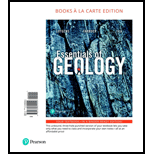
The way in which the two major categories of weathering are represented in the given image of human-made objects.
Answer to Problem 1GST
The broken glass pieces in the image portrays mechanical weathering and the rusted metallic cans depicts chemical weathering.
Explanation of Solution
Weathering may be defined as the “physical breakdown and chemical alteration of rocks at or near to the Earth’s surface.” Weathering could be divided into two significant types namely, the mechanical weathering and chemical weathering.
Mechanical weathering pertains to the disintegration of rocks into simpler and smaller particles without promoting alteration in the mineral chemistry of the undergoing rocks. The weathering of rocks that encompasses the chemical conversion of rocks into one or more newer products is termed as chemical weathering.
The image provided shows broken glass pieces and corroded metallic cans. The broken glass pieces that may be obtained from the breaking of glass bottles, represents the mechanical weathering. The pieces of glass have not undergone any chemical alteration than getting broken into small pieces. There are some round-edged glass pieces that shows the abrasion which took place through the passage of time.
The corroded and rusted metallic cans represented the chemical weathering where the metallic cans suffered chemical transformation into rust (hydrated iron (III) oxides), when exposed to atmospheric oxygen and moisture for a long period of time.
Want to see more full solutions like this?
Chapter 6 Solutions
Essentials of Geology, Books a la Carte Edition (13th Edition)
- Evaporation Evaporation 320,000 km³ Oceans Hydrologic Cycle Precipitation Precipitation 96,000 km³ Precipitation 284,000 km³ Evaporation/Transpiration 60,000 km³ Runoff 36,000 km³ Runoff Infiltrationarrow_forward1. Globally, from which source does more water evaporate into the atmosphere: oceans or land? 2. Approximately what percentage of the total water evaporated into the atmosphere comes from the oceans?Percentage from oceans = Ocean evaporation/Total evaporation × 100% = _____ % 3. Notice in Figure 8.1 that more water evaporates from the oceans than is returned directly by precipitation. If sea level is not dropping, identify a source of water for the oceans in addition to precipitation. 4. Worldwide, about how much of the precipitation that falls on the land becomes runoff: 35, 55, or 75 percent? 5. Much of the water that falls on land does not immediately return to the ocean via runoff. Instead, it is temporarily stored in reservoirs such as lakes. In some mountainous and polar regions, what features serve as reservoirs to temporarily store water?arrow_forwardEnergy conservation is one way to decrease dependence on fossil fuels. What are some things that can be done at home, work, or school that would reduce fossil-fuel use and save money?arrow_forward
- Since the 1970s, the median age of people in North America has done what? Increased Decreased Stayed about the same Decreased dramaticallyarrow_forwardNorth America has experienced a demographic transition that resulted in what kind of changes in the population of North America? Lower birthrates, lower death rates, and longer life expectancies Higher birthrates, lower death rates, and longer life expectancies Lower birthrates, higher death rates, and shorter life expectancies Higher birthrates, higher death rates, and shorter life expectanciesarrow_forwardAccording to the views of animal rights activists opposed to animal experimentation which of the following statements applies? Animal experimentation should be permitted only when medical progress cannot be achieved in any other way. Animal experimentation should be permitted only when the animals involved come from a shelter where they were destined to be killed. Animals have the same rights and moral status that human beings do. We should not apply Kant's Practical Imperative to animals.arrow_forward
- 72 ic 18 The planets 1 Can you find eleven Solar System words in the grid? e E W b V e n a e P r r + h C i - PU 0 0 n c e t S c e r P W n P i t e r U 6 r f U n - K σ г m a r S n W e t Y g n d r e E C Y O P U S t a r > S a t U r n 2 Rearrange the letters into the names of the planets. a ucerr My c un Ves e hrtEa g sarM b ruepitj d rntSau f uneNtep_ h nasu Urarrow_forwardAnswer the photoarrow_forwardwhat are your thoughts on the critical importance of soil management and its impact on agricultural productivity and environmental health, and role of conservation tillage. write in first personarrow_forward
- Five arguments that the Water Bottle Bill was passed as a means of "revenue" enhancement In developing your arguments you should start at the website of the Connecticut State Library which contains the history of all legislation passed by the Connecticut Legislature http://ctstatelibrary.org/leghistory_ to gather the information for your arguments. use referencesarrow_forwardDescribe the importance of recycling household solid wastesarrow_forwardWhy is food waste a growing concern? Describe how some communities are addressing the food waste issue.arrow_forward
 Applications and Investigations in Earth Science ...Earth ScienceISBN:9780134746241Author:Edward J. Tarbuck, Frederick K. Lutgens, Dennis G. TasaPublisher:PEARSON
Applications and Investigations in Earth Science ...Earth ScienceISBN:9780134746241Author:Edward J. Tarbuck, Frederick K. Lutgens, Dennis G. TasaPublisher:PEARSON Exercises for Weather & Climate (9th Edition)Earth ScienceISBN:9780134041360Author:Greg CarbonePublisher:PEARSON
Exercises for Weather & Climate (9th Edition)Earth ScienceISBN:9780134041360Author:Greg CarbonePublisher:PEARSON Environmental ScienceEarth ScienceISBN:9781260153125Author:William P Cunningham Prof., Mary Ann Cunningham ProfessorPublisher:McGraw-Hill Education
Environmental ScienceEarth ScienceISBN:9781260153125Author:William P Cunningham Prof., Mary Ann Cunningham ProfessorPublisher:McGraw-Hill Education Earth Science (15th Edition)Earth ScienceISBN:9780134543536Author:Edward J. Tarbuck, Frederick K. Lutgens, Dennis G. TasaPublisher:PEARSON
Earth Science (15th Edition)Earth ScienceISBN:9780134543536Author:Edward J. Tarbuck, Frederick K. Lutgens, Dennis G. TasaPublisher:PEARSON Environmental Science (MindTap Course List)Earth ScienceISBN:9781337569613Author:G. Tyler Miller, Scott SpoolmanPublisher:Cengage Learning
Environmental Science (MindTap Course List)Earth ScienceISBN:9781337569613Author:G. Tyler Miller, Scott SpoolmanPublisher:Cengage Learning Physical GeologyEarth ScienceISBN:9781259916823Author:Plummer, Charles C., CARLSON, Diane H., Hammersley, LisaPublisher:Mcgraw-hill Education,
Physical GeologyEarth ScienceISBN:9781259916823Author:Plummer, Charles C., CARLSON, Diane H., Hammersley, LisaPublisher:Mcgraw-hill Education,





